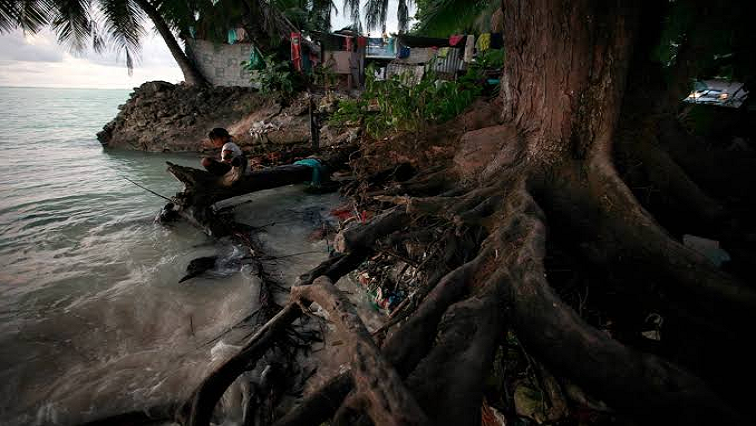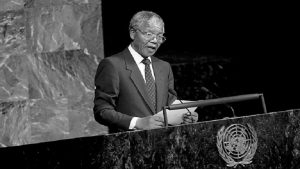As pressure grows on rich countries to help vulnerable nations cope with worsening weather disasters and rising seas, the Green Climate Fund expects to expand its backing for projects that can tackle such “loss and damage”, said its executive director.
“We are, in a lot of regards, already helping countries to take steps in that direction,” Yannick Glemarec said in an interview on the side-lines of the United Nations climate talks in Madrid.
He said countries can apply to the Green Climate Fund (GCF) for finance to put in place early warning systems, weather insurance or infrastructure resilient to climate stresses, for example, and funding of such projects would likely increase in the coming years.
The question of where the money will come from to cover the growing costs of economic and other losses linked to global warming is a hot topic at the UN summit, with wealthy countries reluctant to agree to any new forms of funding for it.
The GCF, created at UN negotiations in 2010, is the biggest global climate fund, and has a mandate to help developing countries reduce their emissions and adapt to climate shifts, but dealing with loss and damage is not specified as part of its mission.
UN work on loss and damage only began in earnest after a mechanism to tackle it was set up in 2013.
But developing states and aid agencies have complained in Madrid that the mechanism has achieved little in terms of offering real help, and will struggle to do so without dedicated finance.
Omar Figueroa, Belize’s minister of state for environment, said loss and damage from climate change was an “existential issue” for low-lying island nations hit by bigger, more frequent storms and rising seas.
Damage from those was costing decades of development gains, he said. “It is time to make this (U.N.) mechanism deliver,” he told journalists at the talks.
Ideally many developing states would like to see a new fund set up specifically to help them address loss and damage.
But with that looking politically impossible, a proposal was tabled in Madrid for the GCF to provide assistance with some aspects of the problem. Those include longer-term pressures such as rising seas forcing coastal dwellers to relocate.
Glemarec said the GCF’s mandate could only be changed by UN negotiators, but he emphasised it had already begun work to help vulnerable nations deal with problems such as land loss.
In the low-lying Pacific country of Tuvalu, for example, it is giving a $36-million grant to protect the atoll nation’s coastlines from intensifying cyclones and encroaching oceans through measures such as rebuilding beaches and putting in place sea walls and barriers to prevent erosion.
Glemarec, a former senior UN official, said he hoped the GCF could start working on its first regional programme for the Pacific in mid-2020 to help island states bolster their infrastructure and economies against climate change impacts.
“It is one of our greatest ambitions to make sure we can play a supportive role,” he added.
PREVENTION LAGS
Another gripe of some of the poorest countries is that accessing money from the GCF is a lengthy and convoluted process; one that is often beyond the limited resources and skills of their government teams.
“We are hearing it a lot – and it’s fair,” said Glemarec.
The young fund, which has only been operating for about five years, will simplify and speed up its project submission and approval procedures in 2020, he added, and offer new tools, including a manual on how to prepare proposals.
However, even though the GCF plans to step up its activities to combat loss and damage, it has only a limited amount of money to spend and that will not be enough, Glemarec warned.
In October, it raised $9.8 billion in fresh funds from rich countries for the next four years. Glemarec said that total would soon reach $10 billion with expected new contributions.
Harjeet Singh, global climate change lead for the charity Action Aid International, said that if the outcome in Madrid was simply to call on existing climate funds and development banks to support loss and damage projects, without requesting additional money for that purpose, it would simply pile pressure on already inadequate international funding.
Such a move would essentially mean “cutting the same cake in many more pieces”, he said on Friday, when the talks are due to end. “We should demand something much more on finance.”
Mami Mizutori, head of the UN Office for Disaster Risk Reduction, said international funding to help countries cope with rising climate risks was sorely lacking. She encouraged the GCF to step in as its mandate and resources allowed.
Data compiled by her agency, which tracks human and economic losses from disasters, showed that, as of October, only eight wealthy countries had reported using foreign aid to help poorer nations cut disaster risks, to the tune of $1 billion in total.
In comparison, “we know that hundreds of billions of dollars’ worth of loss and damage is happening,” Mizutori told the Thomson Reuters Foundation at the Madrid talks.
As the gap between what is needed to recover from disasters and what is being pledged widens, she urged governments to invest far more in preventing extreme weather from hitting people hard.
“The politicians and decision-makers have to have a longer vision of things, not only thinking about the next election cycle,” she said.






